The speed of development of generative AI, boosted by the success of OpenAI's ChatGPT, is raising investor interest in companies working on AI-related infrastructure such as AI chips. Artificial Intelligence (AI) chips are a new generation of microprocessor chips designed to efficiently run AI-related workloads like machine learning, neural networks, and deep learning. As AI technology has advanced rapidly in recent years, there has been increasing demand for hardware optimized for AI processing versus general-purpose computer chips. AI chips are designed to run such AI algorithms faster and more efficiently than traditional processors. This has driven extensive research, development, and investment into AI chip technology by established and emerging companies.
The Global Market for AI Chips 2024-2034 provides a comprehensive analysis of the global AI chip landscape. Spanning over 300 pages, the report covers AI chip technology fundamentals, key capabilities enabled, applications across industries, market segmentation, regional trends, major players, start-up ecosystem, funding and investments, challenges, manufacturing and supply chain dynamics, architectural innovations, sustainability impacts, and the future outlook for these transformative technologies.
Multiple data tables and charts quantify market size projections to 2034 by region, vertical, chip type, and more. Profiles of over 100 companies highlight competitive positioning. Expert insights identify growth opportunities as specialized AI hardware progresses. The Global Market for AI Chips 2024-2034 is ideal for semiconductor industry participants, tech investors, and companies strategizing AI chip adoption to inform planning amid this rapidly evolving space.
Report contents include:
AI Chip Technology Fundamentals
- Architectures like GPUs, ASICs, neuromorphic chips
- Processing capabilities enabled by AI hardware
- Development history and ecosystem
Market Landscape and Segmentation
- Market size forecasts globally and by region
- Breakdown by chip type - ASICs, GPUs, CPUs, FPGAs
- Split by training vs inference workloads
- Segmentation by end-use industry vertical
Regional Analysis
- AI chip development trends in China
- Government policies in the US, Europe, South Korea, Japan
- Edge AI advances by country
Industry Drivers and Adoption Factors
- Key market growth drivers
- Government funding and R&D initiatives
- Corporate investments fuelling innovation
- Applications propelling demand across domains
Competitive Environment
- Profiles of over 130 leading companies. Companies profiled include AMD, Astrus, Celestial AI, Cerebras, d-Matrix, DEEPX, EdgeCortix® Inc., Etched.ai, Enfabrica, Enflame, Google, Horizon Robotics, IBM, Kneron, Lightmatter, Modular, MediaTek Inc, Mythic, Neuchips, Nvidia, Panmnesia, Rebellions, Samsung, SambaNova Systems, Sapeon, SiMa.ai, SpiNNcloud Systems GmbH and Tenstorrent.
- Startups advancing new architectures
- Silicon giants leveraging semiconductor expertise
- Cloud providers and automotive supplier activity
Technology Innovations
- Novel materials, packaging, software abstractions
- Architectural advances in processing, memory, interconnects
- Progress in manufacturing techniques like lithography, 3D stacking
Challenges and Sustainability
- Design, benchmarking, and programming complexities
- Geopolitical implications and policy considerations
- Environmental stewardship priorities and frameworks
This product will be delivered within 1-3 business days.
Table of Contents
1 RESEARCH METHODOLOGY
Companies Mentioned (Partial List)
A selection of companies mentioned in this report includes, but is not limited to:
- AMD
- Astrus
- Celestial AI
- Cerebras
- d-Matrix
- DEEPX
- EdgeCortix® Inc.
- Etched.AI
- Enfabrica
- Enflame
- Horizon Robotics
- IBM
- Kneron
- Lightmatter
- Modular
- MediaTek Inc
- Mythic
- Neuchips
- Nvidia
- Panmnesia
- Rebellions
- Samsung
- SambaNova Systems
- Sapeon
- SiMa.AI
- SpiNNcloud Systems GmbH
- Tenstorrent
Methodology

LOADING...








